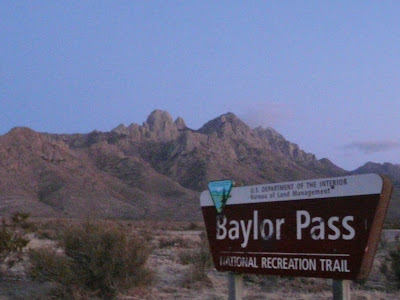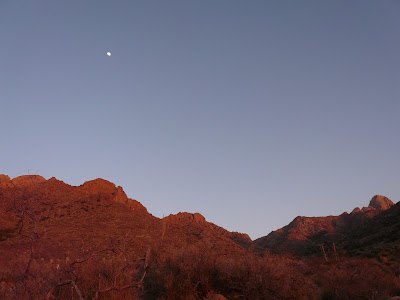 |

Oliver and I had a nice, long visit with the good people at San Andres NWR and enjoyed the MANY things to see and do in the Las Cruces, NM area. Unfortunately, we never had the opportunity to actually visit the refuge. You need special secrutiy clearance or an escort. On several occasions, we had scheduled time with refuge staff to go to the refuge and each time, that intention was interrupted by other business that came up. Yes we were disappointed, but, as you will see, we found other places to spend time. The photos here are of the Baylor Pass recreation area - a place we frequented. It was very close to the refuge complex where we were staying, and we had the choice of hiking into the iconic Organ Mountain Range, or of just running/walking along the flatter, paved access road. We had to take heed of the warning sign (below), posted at the trailhead. It reads "people have died on this trail....." yipes. Without proper water, footwear, food, etc, that is certainly possible.


Oliver doing some scanning at the office. Our work station was a 1-minute walk to our trailer, and was in their conference room space. This location gave us the opportunity to really get to know the folks at San Andres. The internet here also gave us a good spot to do our own thing, watch games, etc, in the evening.
The restricted access of the public to the San Andres NWR allows the refuge to play a role as a pristine, natural laboratory free from heavy human impact, to better-understand the ecology of this northern-most extension of the Chihuahuan Desert. The office is pitcured below, with the tip-tops of the Organ Mountains in the background. We could see those mountains from the living room windown in our trailer. I really enjoyed watching the mountains in all types of light throughout the day and night. We were treated to some spectacular moonlit nights as well during our visit.


Here is another photo of our workspace, with more photos of the office itself.
One of the main objectives of the San Andres National Wildlife Refuge is to sustain the growing population of the bighorn sheep that currently live in the mountains of the refuge. At one point desert bighorn sheep flourished at San Andres NWR growing in numbers from 33 in 1941 (the year the refuge was founded) to 140 in 1950. Five years later, the bighorn population dropped to 70, as the herd was impacted by a severed drought that made it difficult to find enough grass and other plants to eat. The establishment of the White Sands Missile Range eliminated the grazing (and competition for food) of free-ranging livestock raised at area ranches - all of these ranches were purchased by the Missile Range - and the native bighorn herd slowly increased. By the mid-70s there were about 200 found in the peaks and clifss of San Andres. Today, after years of fighting disease, drought and the transfer of about 50 sheep from two nearby natural areas, there are about 100 desert bighrn sheep living in the mountains of the San Andres NWR. Today, the staff at the refuge must work closely with partners at the Range, as well as partners at the White Sands National Monument, balancing the needs and goals of all three entities.
Here's the crew: DelIvan is the area law enforcement officer (above). Below is Ryan (Fire crew), Mara/standing, biologist and bighorn sheep expert, and Lorie/sitting, the office admin person. Mara was our main contact at San Andres and did all sorts of nice things for us.....our favortite was the chance to eat some delicious javelina that her son hunted and she and her family prepared and slow-cooked. We have still not actually seen one of these creatures, very common in this part of the country, but we certainly did enjoy eating one!

In the photo below is Coby, maintainance and big machine-operator for the refuge.
Just up the highway from the San Andres NWR office complex where we stayed is one of the most amazing places we have visited on this journey: the White Sands National Monument. As the name implies, this protected area is the largest gypsum dune field in the world, 275 square miles of white sand dunes. It lies in the Tularosa Basin on the northern edge of the Chihuahuan Desert, east of the San Andres NWR, and because it is a basin, collects the run-off of the white gypusm that comes off of the mountains that surround it (Sacremento and San Andres). Although there is much more science and history involved in how this incredibly-cool place evolved, we just know how much fun it was to be here. As you will see in the photos below, it is a photographer's dream. The light continually changes here as do the shape and size of the sand dunes. It is also just so unusual to be in a place that looks like piles of snow, yet it is piles of white sand. We took many more photos than are on this photo blog, but we hope you enjoy the ones posted here.
.

We thought this picnic area looked like something out of "Star Wars." This picture was taken on a very windy and cool evening, not a good night for eating outside.
Oliver would run on the white sand dunes for over an hour at a time....he loved it and I marveled at his ability to exercise for so long on soft hills of sand; not easy.
One Saturday, we headed to Mesilla, a charming little village, just outside of downtown Las Cruces. Mesilla was one time a town in Mexico, part of Chihuaua. It was included in the Gadsden Purchase then became part of the US. We walked around through the shops and small park, and ate lunch on the outdoor courtyard at La Posta, an historic restaurant (yummy food) that used to be a stop on the Butterfield Stagecoach line that ran from St. Louis to San Francisco. There is so much history in this part of the country and many of the buildings here are original. Apparently Billy the Kid was tried here - ultimately escaped the jail here, before he was later found northeast of here and shot.
We also visited the Museum of Space History and the International Space Hall of Fame, down the road in Alamagordo, NM. It sits on a hill overlooking the Tularosa Basin, White Sands NM, and the town of Alamagordo. We went to see two short space films in their IMAX, but were pleasantly surprised by the museum itself. It was loaded with information on the global efforts of space exploration and had a lot of cool historic pieces of equipment, photos, stories and information. We learned and enjoyed.
We really enjoyed our time in southern New Mexico and were sad to leave here too. This makes a terrific place for a vacation as there is so much to do and lots of interesting and delicious food to eat. The last two photos were taken at White Sands National Monument.
















































































































No comments:
Post a Comment